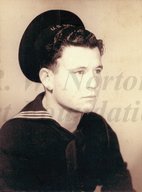
|

|
|
|
|
James was born at home in Hosston, Louisiana, a cotton farming and oil field community. His father, Madison Castle Wilkerson, built wooden derricks and worked at Bayou State Refinery. He died as the result of an oilfield injury at age forty-four, leaving a widow, Betty Alley Brown Wilkerson, and four children. James, known as "Bubba" to his friends and family, delivered newspapers, sold magazines, and worked at H.P. Wilson's Grocery Store, earning a dollar and a quarter for a weekend. He saved that money to buy a pair of shoes. Much of the family's diet consisted of peas, beans, "dry salt meat" and cornbread. James graduated from Hosston High School in 1941. He was attending Norton Business College when Pearl Harbor was attacked. James worked as an office clerk in an oilfield equipment company, and then for Louisiana Army Ammunition Plant in Doyline. He enlisted in the U.S. Navy because "I didn't want to walk," he says. He went to boot camp in San Diego, and then to Diesel Engineering School in Columbia, Missouri, and Norfolk, Virginia. At Jacksonville, Florida, he was assigned to a minesweeper, the USSYMS 350, a wooden vessel on which he maintained the two, eight-cylinder engines. He says the vessel did not have a name. James sailed to Europe from Norfolk, Virginia, on December 19, 1943. Although he had never been aboard a boat on water, he says he never got seasick on the nine-day voyage to Falmouth, England. There they began running escort duty for ships through Dover Straits. James served with one African-American sailor, K.D. Friend, a Shreveport resident, who served as officers' attendant. "He didn't go ashore," recalls James. "When we hit port he'd stay aboard. If he needed anything, he'd give us money to bring it back." At D-Day, he says the minesweeper joined many other vessels to perform a "break water," in which ships were aligned end-to-end to make the surface smoother for incoming landing crafts. His ship was near Omaha Beach. He recalls the bodies from the beach, "a lot of them," floating face down in the water. After D-Day his vessel swept mines in Cherbourg Harbor where troop and supply ships were landing. After they had finished their mission, on July 2, 1944, a mine exploded under the ship. It sank in twelve minutes. James' left leg was broken in the incident. He recuperated at Queen Victoria Hospital in Southampton, England, and then was brought back to America, where he underwent more treatment in Chelsea, Massachusetts. By accident, he encountered two friends from Louisiana working aboard the ship--Earl Williamson from Vivian, and Rudy Thigpen of Hosston, who had finished a tour of duty with the U.S. Army Air Forces. From his wounding until his discharge in New Orleans, his recovery took two years and two weeks. He says his leg "still bothers me." He draws full disability. After the war he clerked at Dixie Metal Supply Company in Shreveport, and married Joan Hicks in November of 1946. They would have two children and three grandchildren. He attended Centenary College for two years. He later worked in pipe fitting in Louisiana, Ohio, and finally in Kilgore, Texas. He returned to Shreveport in 1960. He says he was fired from his pipe fitter position at Western Electric in 1980 for "acute alcoholism." James says he has remained sober since April 19, 1984. He stays active in Alcoholics Anonymous. |


